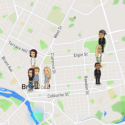Snapchat has attempted to keep its throne by adding new a feature Snap Map.
In an effort to keep its users from abandoning it for other platforms, like Instagram, Snapchat has added a map plug-in. This plug-in, called the Snap Map, shows users local stories and the location of their friends. To access the feature, users pinch on the screen and accept the terms and conditions. Afterwards, the app asks how private the user would like their location to be. The choices are “ghost”, “select friends”, and “public”.
Snapchat is marketing this feature as a way to “see what’s happening, find your friends, and get inspired to go on an adventure”. Unfortunately, even with the privacy settings, the update comes with a creepy vibe.
The feature, at its simplest, is a way to find out where someone is. It is easy to brush this off by saying “So what? I don’t care.” However, the risks can be greater than what first comes to mind. The map could show that someone’s significant other was at a jewelry store – maybe they are buying a ring? It could also make it easier for stalkers to keep track of someone’s location. The map also shows whether someone is driving, shopping, or listening to music.
Another fear is that this personal information about where you spend the most time, such as at work, home and shopping, can be sold to make a quick profit. Snap Inc. has been stumbling trying to find a way to make its app profitable. Between January and May this year, the company has lost roughly $2.2 billion. In the case that the company is sold to regain these losses, Snap Inc. has warned that all information it stores would be included.
The Snapchat privacy policy states, “If Snap Inc. gets involved in a merger, asset sale, financing, liquidation or bankruptcy, or acquisition of all or some portion of our business to another company, we may share your information with that company before and after the transaction closes.”
This data can be sold, without permission, to advertisers, analysts, and absolutely anyone else. When coupled with personal information gathered from cookies in web browsers, search history, and online purchases, a portrait of someone’s characteristics can be made. This portrait can then easily be used to market products more effectively. While there is no obvious evil within seeing products that are more interesting on a personal level, it opens a door. Using this personal data, dubbed “Big Data”, any person, company or government can make assumptions about a person to make business decisions. For example, a bank might refuse a loan or insurance rates could be raised.




